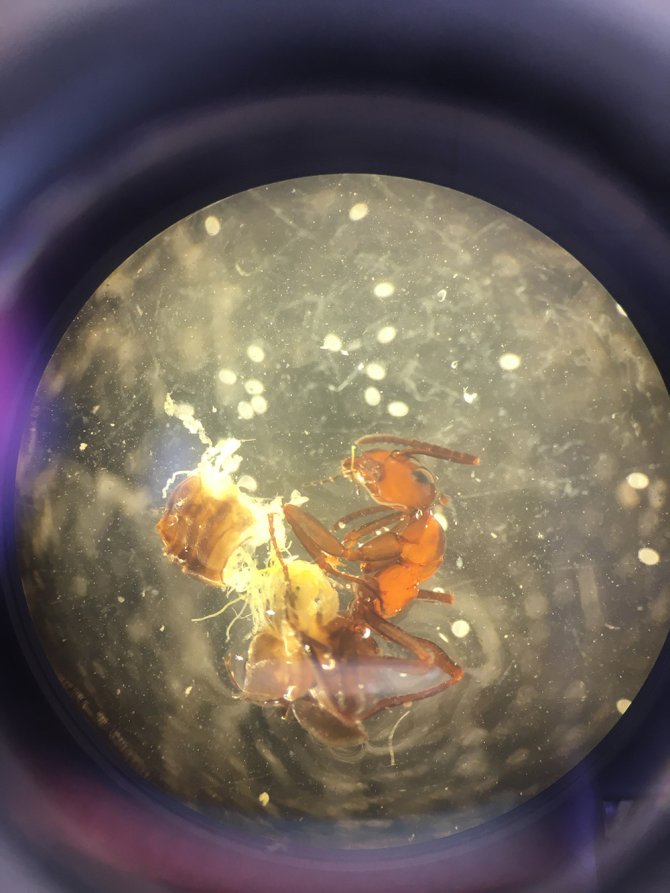News
When the temperature drops, parasites turn ants into zombies
Field research conducted at the University of Copenhagen by current WUR researcher Simone N. Gasque together with her MSc thesis supervisor Associate Professor Brian Lund Fredensborg has now confirmed the long-held assumption of a strong relationship between temperature and the changing behaviour of ants infected with the lancet liver fluke (Dicrocoelium dendriticum). For her Master's thesis, she studied the behaviour of hundreds of ants in the forest. Her study showed that the ants express a behaviour induced by a parasite infecting them, by attaching themselves by biting onto vegetation, such as grass and leaves. This behavioural change of infected ants does not happen at high temperatures.
Like many other organisms, parasites go through several stages to complete their life cycle: from egg through larva to adult. To do this, some parasites must pass through various hosts, explains biologist and parasitologist Simone N. Gasque (currently PhD-candidate). "In the case of the lancet liver fluke, the hosts are snails, ants and mammals, usually deer.”
The parasite needs to go through all these different ones to fulfil their lifecycle and be able to reproduce, says Gasque. “In a snail, the flatworm grows into a larval stage, which then infects an ant by them consuming a slimeball coughed up by the snail. In the ant, the larva continues to develop, and it is in this host we see a behavioural change. So that finally, the parasite can infect a mammal and reach adulthood."
Parasites transform ants into zombies
To parasitise a mammal, the lancet liver fluke must compel an ant to attach itself to vegetation. "A deer does not eat stray ants deliberately, but it does eat grass or other plants that may have ants on them," Gasque explained. "Normally, ants are always on the move, such as when they forage for food. But this parasite can temporarily affect the ant's behaviour. This turns the ant into a kind of zombie and makes it do what the parasite wants, which is to bite onto vegetation and remain there for the time being. Because the ants mandibles are locked to the grass in a tetanus it is more likely to be eaten by a grazer."
Field survey in Danish forest
This process has been known since the 1950s, says Gasque. But the dominant factor for this behaviour had not yet been established. "From the 1970s and 1980s, researchers assumed that temperature or the time of day could play an important role. But there was no hard evidence for this. Some years ago a study in the Fredensborg lab at the University of Copenhagen showed a correlation between temperature and the biting behaviour under laboratory conditions. But until now this has not been done in the infected ants natural setting, which is why I started doing field research.”
Gasque did field research over a year in a Danish forest, during which she tracked hundreds of infected ants for a total of 13 days. “On 172 ants I also attached small, coloured tags to their back parts. Each tag was numbered so I could closely track the individuals. I also recorded the temperature, relative humidity and time using measuring equipment."
Biting onto foliage at low temperatures
During measurements Gasque saw that the ants bit onto the vegetation especially early in the morning and in the evening. During the day, when the temperature rose to high degrees, they did not stay attached to the vegetation. Gasque: "Based on the setup we cannot pinpoint a precise temperature threshold, but I did see that infected ants bit down considerably at about 8 degrees.”
When the temperature remained low, as in the fall, they sometimes were immobilised all day, says Gasque. “On hot summer days, at 36 degrees and above, none or only extremely few exhibited this behaviour. Because the parasite affects behaviour during low temperatures, this increases the likelihood of transmission to its next host. After all, deer graze at dawn and dusk where the temperatures are low."
Interesting topic for follow-up research
Exactly what mechanisms underlie the parasitic control of ant behaviour needs further investigation, Gasque said. "It could be a particular gene for example encoding a specific protein, or an immune system response due to the infection of the parasite. Looking into the mechanisms behind the change of behaviour is what I have been working on here at WUR, but with another behavioural altering parasite, baculoviruses infecting caterpillars.

Furthermore for the lancet liver fluke, it would be interesting to study other factors in more detail. At least we now know that temperature is the most important factor and that there is no significant relationship between ant biting behaviour due to infection and humidity, solar radiation or time of day. But as we used a proxy (calculated measure based on other factors) it could be interesting to measure the real solar radiation in the microclimate of these infected ants.”